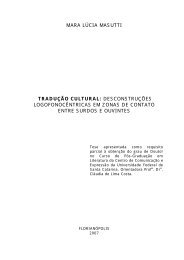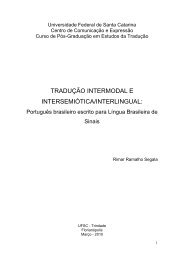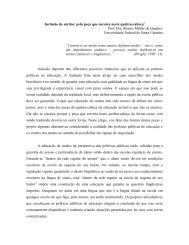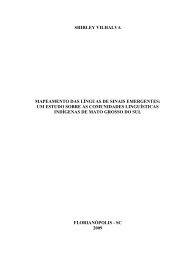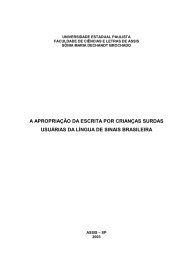Phrase Structure of Brazilian Sign Language - Ronice.cce.prof.ufsc.br
Phrase Structure of Brazilian Sign Language - Ronice.cce.prof.ufsc.br
Phrase Structure of Brazilian Sign Language - Ronice.cce.prof.ufsc.br
Create successful ePaper yourself
Turn your PDF publications into a flip-book with our unique Google optimized e-Paper software.
Mary likes John and he does also.<<strong>br</strong> />
_____eg ___hn ____eg ___hn<<strong>br</strong> />
c) *aMARY bJOHN aAUXb [LIKE]i, JOHN TOO [e]I<<strong>br</strong> />
Mary likes John and he also.<<strong>br</strong> />
In LSB, ellipsis without an auxiliary is not allowed:<<strong>br</strong> />
__hn<<strong>br</strong> />
(33) a) *JOHN LIKE MARY, MARY TOO.<<strong>br</strong> />
John likes Mary and Mary also<<strong>br</strong> />
____eg ___hn<<strong>br</strong> />
b) bJOHN LIKE aMARY, aAUXb TOO<<strong>br</strong> />
John likes Mary and (she) does also.<<strong>br</strong> />
I have seen so far that plain verbs behave in the same way as main<<strong>br</strong> />
verbs in English. That is, following Lasnik’s proposal, these verbs are affixal and<<strong>br</strong> />
must merge with their respective affixes as a consequence <strong>of</strong> a phonological<<strong>br</strong> />
requirement under adjacency. I also observed in (18) that the affixal approach can<<strong>br</strong> />
not explain the lexical negation that takes place in sentences with inflecting verbs,<<strong>br</strong> />
which suggests the existence <strong>of</strong> an asymmetry. If I am on the right track, I must now<<strong>br</strong> />
explain how the structure works with inflecting verbs. Let us see if there is an<<strong>br</strong> />
analogy between inflecting verbs and the featural approach for verbal morphology<<strong>br</strong> />
presented by Lasnik (1995).<<strong>br</strong> />
The featural approach observed with auxiliaries in English and main<<strong>br</strong> />
verbs in French, as well as in Swedish, presents the following characteristics:<<strong>br</strong> />
(xxi) These verbs precede negation when they have “strong” features and follow<<strong>br</strong> />
negation when they have “weak” ones (the first case is observed in English<<strong>br</strong> />
and French: John has no idea about the game and Jean (n’)aime pas Marie;<<strong>br</strong> />
the second case is observed in Swedish, …, om hon inte <strong>of</strong>ta har sett<<strong>br</strong> />
honnom) 11 . This also is observed in LSB with agreement verbs (examples<<strong>br</strong> />
(34) and (35)):<<strong>br</strong> />
(34) ______________________neg/eg<<strong>br</strong> />
JOHNa NO aGIVEb BOOK MARYb.<<strong>br</strong> />
John did not give the book to Mary.<<strong>br</strong> />
(35) _______________neg/eg<<strong>br</strong> />
JOHNa NO bCARRY-BOXc.<<strong>br</strong> />
John did not carry the box (from here to there).<<strong>br</strong> />
(xxii) Verbs as have and be in English do not need do-support (John has no idea<<strong>br</strong> />
about the game results). Considering AUX in LSB as something similar to<<strong>br</strong> />
do-support the same distribution is observed (example (36)):<<strong>br</strong> />
11<<strong>br</strong> />
Glosses to French and Swedish examples respectively:<<strong>br</strong> />
John likes not Mary<<strong>br</strong> />
…, whether she not <strong>of</strong>ten has seen him<<strong>br</strong> />
11



